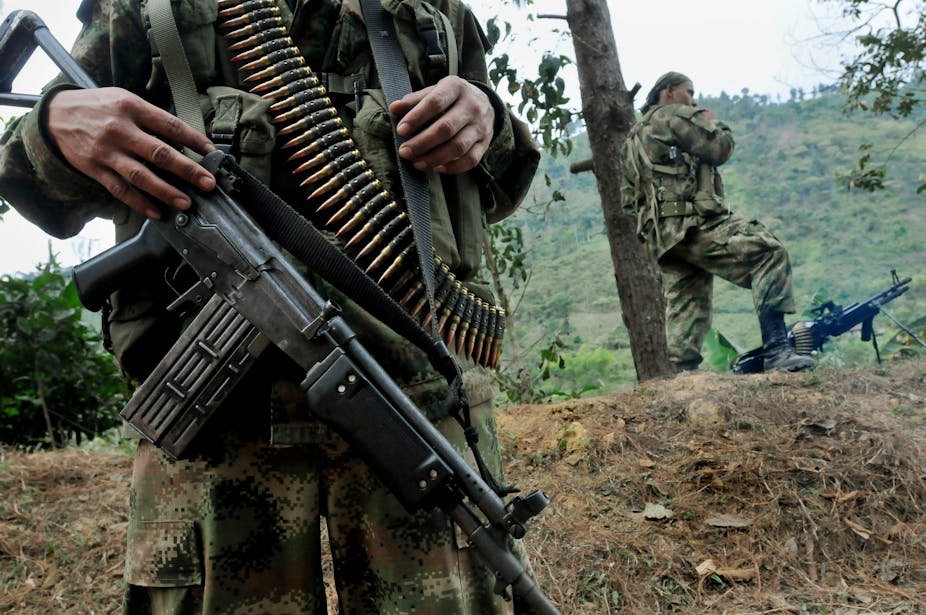Last month marked the one year anniversary of peace talks between the Colombian government and the western hemisphere’s oldest and strongest insurgency – the Revolutionary Armed Forces of Colombia (the FARC). While initial momentum, goodwill and timing initially suggested a positive end to final negotiations, there has been a growing sense of crisis, with a perceived lack of progress.
Despite this, the government and the FARC have reached a “fundamental agreement” on the movement’s future political role. Does this suggest that success in the form of a peace settlement with the insurgency may be on the horizon?
Background of the FARC
The FARC was founded in 1964 by Manuel Marulanda Veléz, with an original aim to overthrow the Colombian government and implement a state structure heavily influenced by Marxism-Leninism.
Predating the Cuban Revolution and claiming to represent Colombia’s rural poor, the FARC has consistently promoted a radical transformation of Colombia’s capitalist system through collective armed struggle. At the height of its power in 2002, figures suggest that the FARC maintained roughly 19,000 fighters and controlled roughly 40% of the country’s land. Recently, this is believed to have dropped to around 8,000 militants.
Though actively engaged to an extent in Colombia’s coca industry, the FARC has maintained a degree of popular support in recent years by shifting its ideology to a Colombian-specific Bolivarianism, and mobilising on a platform opposing privatisation and calling for the redistribution of wealth.
The haunting of the past
It is starkly clear that Colombian president Juan Manuel Santos has taken a different approach to the FARC than his predecessor Alvaro Uribe, whose term was characterised by a hardline military approach against the insurgency.
In a surprise announcement in September 2012, Santos expressed that the government and the FARC had reached an agreement that lays out a roadmap for negotiations. However, this is not the first time the Colombian government has entered into negotiations with the FARC.
The last peace effort between 1998 and 2002 failed dismally. After former president Andrés Pastrana granted the FARC a safehaven to promote talks, the guerrillas utilised this space for training purposes and to set up camps for both political and civilian hostages.
This not only contributed to the strengthening of the movement at the time, but the consideration of this past issue has partially influenced the Colombian government’s decision not to agree on a bilateral ceasefire in the current round of negotiations.
What is different this time around?
Despite the slow pace of current negotiations and the absence of a ceasefire, there appears to be a stronger determination among both parties for a peace settlement. In April 2012, the FARC declared it would no longer engage in its renowned tactic of kidnapping political hostages for ransom as a peace gesture, signifying it is ready for a negotiated settlement.

However, this move was recently questioned when the FARC took a US citizen hostage in July. There has also been a notable shift in government rhetoric by Santos away from regarding the conflict as a fight between the Colombian government and a “terrorist organisation”. A ten year ban on the FARC’s affiliated political wing – the Patriotic Union – has been lifted.
Though sceptics are keen to point out the fact that negotiations can be utilised by the FARC as a façade of “legitimacy” to strengthen and re-group as a result of recent losses, it is actually a recognition of the movement’s grievances that the Colombian government is bringing to the table. The FARC have suffered significant leadership losses and desertions over the last decade.
However, it is also clear that the guerrillas who continue to fight with the FARC are almost overwhelmingly from peasant families. The growing inequality gap in the Colombia is recorded as one of the worst in the western hemisphere.
As a consequence of the socioeconomic divides, the key points in the negotiations between the Colombian government and the FARC are: land and agrarian reforms (a consistent FARC objective); how best to decrease the production of illicit drugs; justice and reparations for victims; how to end the conflict; and the future of the movement, including the possibility of incorporation into the political system.
Without the ceasefire, violence has continued throughout the negotiations. In July, Santos threatened a full-blown retaliation against the insurgency after it killed 19 soldiers in a day.
The announcement regarding the FARC’s political role marks a much-needed boost for the present round of negotiations, and the outlook is looking positive. However, with Santos’ November 25 deadline to seek a second presidential term also fast approaching, it really is reaching crunchtime.
So far, the government has achieved a partial agreement on “comprehensive rural reform” (announced in May), and the recent announcement regarding the FARC’s political incorporation suggests a positive acknowledgement of the movement’s support amongst the population.
It is still hopeful that this round of negotiations will be successful. However, with delays, deadlines, and the country’s patience not “infinite”, the clock is ticking.

